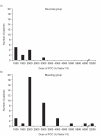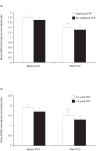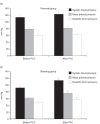Prothrombin complex concentrate in surgical patients: retrospective evaluation of vitamin K antagonist reversal and treatment of severe bleeding
- PMID: 19948037
- PMCID: PMC2811941
- DOI: 10.1186/cc8186
Prothrombin complex concentrate in surgical patients: retrospective evaluation of vitamin K antagonist reversal and treatment of severe bleeding
Abstract
Introduction: Prothrombin complex concentrates are recommended for rapid reversal of vitamin K anticoagulants. As they normalize levels of vitamin K dependent clotting factors and re-establish hemostasis, they may also be used as adjunctive therapy in patients with major bleeding. The aim of this study was to retrospectively evaluate the efficacy of prothrombin complex concentrates in the surgical setting.
Methods: The case notes of 50 patients requiring urgent oral anticoagulation reversal (n = 12) or with severe perioperative coagulopathic bleeding (n = 38) who received an infusion of prothrombin complex concentrate (Beriplex P/N(R) 500) at the surgical department of the University of Munich Hospital, Germany were retrospectively reviewed. Efficacy of prothrombin complex concentrate application was evaluated using the Quick test, reported as an international normalized ratio, hemodynamic measurements and requirement for blood products. Safety assessments included whole blood hemoglobin levels and specific parameters of organ dysfunction.
Results: Baseline characteristics were comparable, except that mean baseline international normalized ratio and hemoglobin levels were significantly higher (P < 0.01) in anticoagulation reversal than in bleeding patients. In anticoagulation reversal, the international normalized ratio was significantly reduced (from 2.8 +/- 0.2 at baseline to 1.5 +/- 0.1, P < 0.001) after one prothrombin complex concentrate infusion (median dose 1500 IU; lower quartile 1,000, upper quartile 2,000). No major bleeding was observed during surgery after prothrombin complex concentrate administration. Only one patient received platelets and red blood cell transfusion after prothrombin complex concentrate administration. In bleeding patients, infusion of prothrombin complex concentrate (median dose 2,000 IU; lower quartile 2,000, upper quartile 3,000) significantly reduced the INR from 1.7 +/- 0.1 at baseline to 1.4 +/- 0.1 (P < 0.001). This decrease was unrelated to fresh frozen plasma or vitamin K administration. Bleeding stopped after prothrombin complex concentrate administration in 4/11 (36%) patients with surgical bleeding and 26/27 (96%) patients with diffuse bleeding. Hemoglobin levels increased significantly from baseline in bleeding patients (P < 0.05) and mean arterial pressure stabilized (P < 0.05). No thrombotic events or changes in organ function were reported in any patient.
Conclusions: Prothrombin complex concentrate application effectively reduced international normalized ratios in anticoagulation reversal, allowing surgical procedures and interventions without major bleeding. In bleeding patients, the improvement in coagulation after prothrombin complex concentrate administration was judged to be clinically significant.
Figures







Similar articles
-
Efficacy and safety of a 4-factor prothrombin complex concentrate in patients on vitamin K antagonists presenting with major bleeding: a randomized, plasma-controlled, phase IIIb study.Circulation. 2013 Sep 10;128(11):1234-43. doi: 10.1161/CIRCULATIONAHA.113.002283. Epub 2013 Aug 9. Circulation. 2013. PMID: 23935011 Free PMC article. Clinical Trial.
-
Prothrombin Complex Concentrates for Perioperative Vitamin K Antagonist and Non-vitamin K Anticoagulant Reversal.Anesthesiology. 2018 Dec;129(6):1171-1184. doi: 10.1097/ALN.0000000000002399. Anesthesiology. 2018. PMID: 30157037 Free PMC article. Review.
-
Activated Prothrombin Complex Concentrate Versus 4-Factor Prothrombin Complex Concentrate for Vitamin K-Antagonist Reversal.Crit Care Med. 2018 Jun;46(6):943-948. doi: 10.1097/CCM.0000000000003090. Crit Care Med. 2018. PMID: 29498942
-
Vitamin K Antagonist Reversal for Urgent Surgery Using 4-Factor Prothrombin Complex Concentrates: A Randomized Clinical Trial.JAMA Netw Open. 2024 Aug 1;7(8):e2424758. doi: 10.1001/jamanetworkopen.2024.24758. JAMA Netw Open. 2024. PMID: 39088218 Free PMC article. Clinical Trial.
-
[Bleeding risk and perioperative management of patients anticoagulated with vitamin K antagnosists].Wien Med Wochenschr. 2008;158(21-22):615-20. doi: 10.1007/s10354-008-0610-3. Wien Med Wochenschr. 2008. PMID: 19052707 Review. German.
Cited by
-
Spanish Consensus Statement on alternatives to allogeneic blood transfusion: the 2013 update of the "Seville Document".Blood Transfus. 2013 Oct;11(4):585-610. doi: 10.2450/2013.0029-13. Epub 2013 Jun 17. Blood Transfus. 2013. PMID: 23867181 Free PMC article. No abstract available.
-
Use of prothrombin complex concentrate for excessive bleeding after cardiac surgery.Interact Cardiovasc Thorac Surg. 2012 Sep;15(3):382-9. doi: 10.1093/icvts/ivs224. Epub 2012 May 23. Interact Cardiovasc Thorac Surg. 2012. PMID: 22623627 Free PMC article.
-
Rotation thromboelastometry (ROTEM) enables improved outcomes in the pediatric trauma population.J Int Med Res. 2018 Dec;46(12):5195-5204. doi: 10.1177/0300060518794092. Epub 2018 Sep 10. J Int Med Res. 2018. PMID: 30200794 Free PMC article.
-
The epidemic of pre-injury oral antiplatelet and anticoagulant use.Eur J Trauma Emerg Surg. 2014 Dec;40(6):657-69. doi: 10.1007/s00068-014-0404-9. Epub 2014 May 1. Eur J Trauma Emerg Surg. 2014. PMID: 26814780
-
Use of prothrombin complex concentrate in warfarin anticoagulation reversal in the emergency department: a quality improvement study of administration delays.BMC Health Serv Res. 2015 Mar 15;15:106. doi: 10.1186/s12913-015-0775-6. BMC Health Serv Res. 2015. PMID: 25880097 Free PMC article.
References
Publication types
MeSH terms
Substances
LinkOut - more resources
Full Text Sources
Medical
Research Materials

